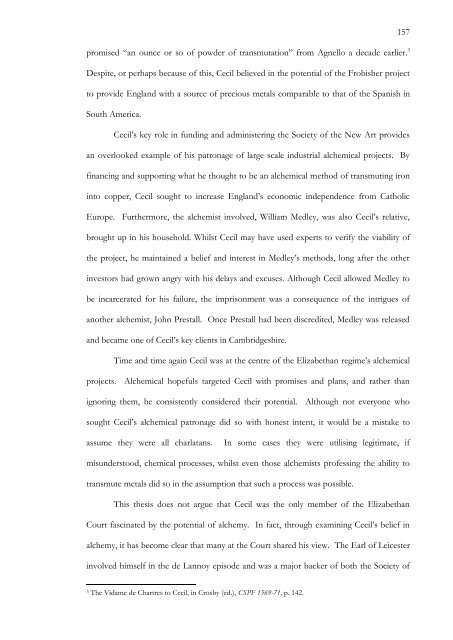The Alchemical Patronage of Sir William Cecil, Lord Burghley
The Alchemical Patronage of Sir William Cecil, Lord Burghley
The Alchemical Patronage of Sir William Cecil, Lord Burghley
You also want an ePaper? Increase the reach of your titles
YUMPU automatically turns print PDFs into web optimized ePapers that Google loves.
promised ―an ounce or so <strong>of</strong> powder <strong>of</strong> transmutation‖ from Agnello a decade earlier. 3<br />
Despite, or perhaps because <strong>of</strong> this, <strong>Cecil</strong> believed in the potential <strong>of</strong> the Frobisher project<br />
to provide England with a source <strong>of</strong> precious metals comparable to that <strong>of</strong> the Spanish in<br />
South America.<br />
<strong>Cecil</strong>‘s key role in funding and administering the Society <strong>of</strong> the New Art provides<br />
an overlooked example <strong>of</strong> his patronage <strong>of</strong> large scale industrial alchemical projects. By<br />
financing and supporting what he thought to be an alchemical method <strong>of</strong> transmuting iron<br />
into copper, <strong>Cecil</strong> sought to increase England‘s economic independence from Catholic<br />
Europe. Furthermore, the alchemist involved, <strong>William</strong> Medley, was also <strong>Cecil</strong>‘s relative,<br />
brought up in his household. Whilst <strong>Cecil</strong> may have used experts to verify the viability <strong>of</strong><br />
the project, he maintained a belief and interest in Medley‘s methods, long after the other<br />
investors had grown angry with his delays and excuses. Although <strong>Cecil</strong> allowed Medley to<br />
be incarcerated for his failure, the imprisonment was a consequence <strong>of</strong> the intrigues <strong>of</strong><br />
another alchemist, John Prestall. Once Prestall had been discredited, Medley was released<br />
and became one <strong>of</strong> <strong>Cecil</strong>‘s key clients in Cambridgeshire.<br />
Time and time again <strong>Cecil</strong> was at the centre <strong>of</strong> the Elizabethan regime‘s alchemical<br />
projects. <strong>Alchemical</strong> hopefuls targeted <strong>Cecil</strong> with promises and plans, and rather than<br />
ignoring them, he consistently considered their potential. Although not everyone who<br />
sought <strong>Cecil</strong>‘s alchemical patronage did so with honest intent, it would be a mistake to<br />
assume they were all charlatans. In some cases they were utilising legitimate, if<br />
misunderstood, chemical processes, whilst even those alchemists pr<strong>of</strong>essing the ability to<br />
transmute metals did so in the assumption that such a process was possible.<br />
This thesis does not argue that <strong>Cecil</strong> was the only member <strong>of</strong> the Elizabethan<br />
Court fascinated by the potential <strong>of</strong> alchemy. In fact, through examining <strong>Cecil</strong>‘s belief in<br />
alchemy, it has become clear that many at the Court shared his view. <strong>The</strong> Earl <strong>of</strong> Leicester<br />
involved himself in the de Lannoy episode and was a major backer <strong>of</strong> both the Society <strong>of</strong><br />
3 <strong>The</strong> Vidame de Chartres to <strong>Cecil</strong>, in Crosby (ed.), CSPF 1569-71, p. 142.<br />
157















